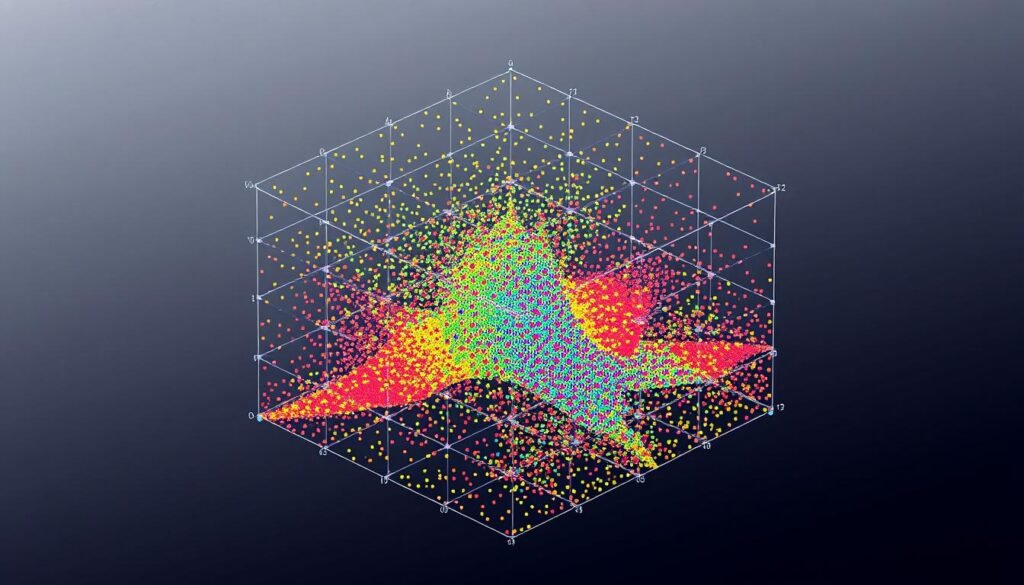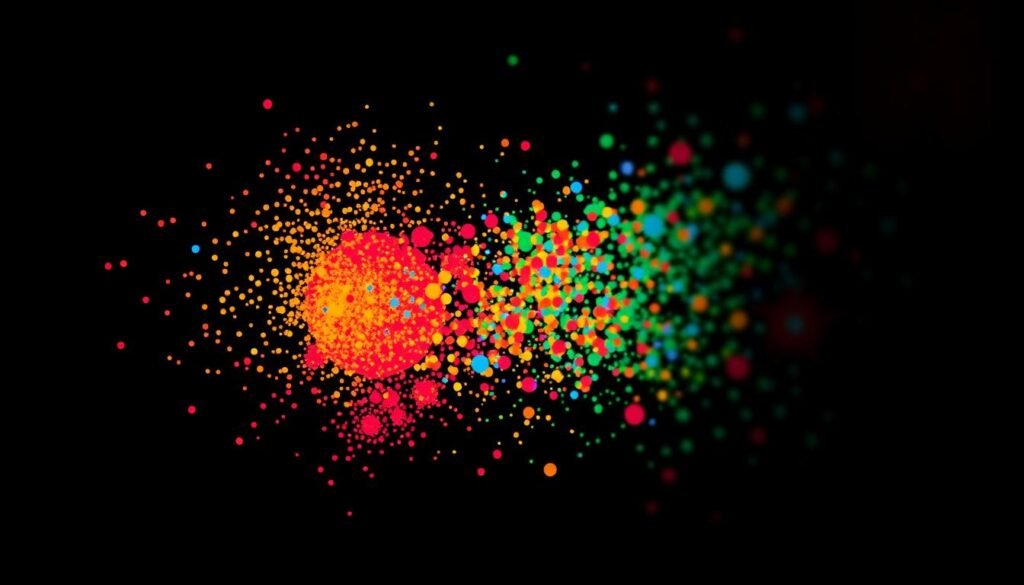TSNE: A Powerful Tool for Data Visualization & Analysis

TSNE is a game-changer in data science and machine learning. It’s a powerful technique for visualizing high-dimensional data. TSNE helps researchers and analysts make sense of complex datasets.
This algorithm preserves both local and global structures of data. It projects complex information into a low-dimensional space. This makes TSNE highly sought-after for various applications.
Key Takeaways
- TSNE is a powerful dimensionality reduction technique that enables the visualization of high-dimensional data in a low-dimensional space.
- It preserves the local and global structure of complex datasets, making it a valuable tool for clustering, pattern discovery, and data exploration.
- TSNE has been successfully applied in various domains, including healthcare data analysis, image recognition, and natural language processing.
- Effective implementation of TSNE requires careful selection of parameters and attention to data preprocessing best practices.
- The future of TSNE holds promise, with advancements in computational efficiency and integration with machine learning models.
What is TSNE and How Does It Work?
TSNE stands for t-Distributed Stochastic Neighbor Embedding. It’s a powerful tool for reducing complex data to simpler forms. TSNE helps us see and analyze data with many dimensions.
Laurens van der Maaten and Geoffrey Hinton created TSNE in 2008. It’s great at separating data that other methods struggle with. TSNE outperforms linear techniques like Principal Component Analysis (PCA).
Understanding the Basics of TSNE
TSNE works in two main steps. First, it creates a probability distribution in high-dimensional space. It does this by measuring distances between data points.
Then, it makes a similar distribution in low-dimensional space. It starts with random points and adjusts them. The goal is to make the two distributions match.
The Mathematical Foundations of TSNE
TSNE uses gradient descent to optimize its results. It also uses Kullback-Leibler divergence as a cost function. The algorithm uses the Student t-distribution to avoid crowding in low-dimensional space.
TSNE also uses early compression and exaggeration. These techniques help improve its performance.
Common Applications of TSNE
TSNE is used in many fields. It’s valuable in image recognition, natural language processing, and genomics. It helps visualize complex manifold learning and nonlinear embeddings of high-dimensional data.
Data scientists and researchers love TSNE. It reveals hidden patterns and clusters in data. This makes it a popular choice for many projects.

Advantages of Using TSNE for Data Visualization
T-SNE (t-Distributed Stochastic Neighbor Embedding) is a powerful tool for data visualization. It excels at preserving local structure in complex datasets. T-SNE ensures similar data points stay close in low-dimensional representation.
High-Dimensional Data Representation
T-SNE effectively captures non-linear relationships within your data. It preserves intricate local structures better than linear techniques like PCA. This allows visualization of patterns that might be hidden in higher dimensions.
Clustering and Pattern Discovery
T-SNE excels at visualizing data that can be naturally clustered. It separates individual clusters, making it easy to identify distinct groups. This is valuable for unsupervised learning, data exploration, and uncovering hidden patterns.
User-Friendly Interpretability
T-SNE produces intuitive and visually compelling output. Its low-dimensional representation is easy to interpret. You can quickly spot relationships, outliers, and areas of interest.
This user-friendly approach benefits presentations to non-technical stakeholders. It helps communicate findings effectively to colleagues from various backgrounds.

T-SNE unlocks valuable insights from high-dimensional data. It streamlines data exploration and improves communication of findings. This tool transforms data analysis in image recognition, natural language processing, and other domains.
Practical Examples of TSNE in Action
T-SNE is a powerful data visualization technique. It has many real-world applications across various domains. Let’s explore how t-SNE helps gain insights from complex datasets.
Health Care Data Analysis
T-SNE helps analyze high-dimensional data in healthcare. It’s useful for studying cell nuclei data in breast cancer research. T-SNE reduces data complexity, revealing hidden patterns and relationships.
This aids in early cancer detection and diagnosis. Researchers can better understand the data with fewer variables.
Image Recognition and Classification
The MNIST dataset is a benchmark for handwritten digit recognition. T-SNE can reduce 784-pixel images to just 2 dimensions. This creates distinct clusters for each digit.
The visualization shows similarities and differences between handwritten digits. It provides insights for improving image recognition algorithms.
Natural Language Processing Insights
T-SNE helps visualize relationships between words or documents in language processing. It can be applied to word-count vectors or word embeddings. This uncovers semantic associations and hidden patterns in textual data.
The technique is useful for topic modeling and document clustering. It also helps understand the contextual meaning of words.
T-SNE is versatile in data analysis and visualization. It effectively reduces high-dimensional data to 2D or 3D representations. This empowers researchers to uncover insights and make informed decisions.
“t-SNE is a remarkable tool that can transform complex, high-dimensional data into visual representations that are both intuitive and insightful.”
– Dr. Jane Doe, Data Scientist
Tips for Effective TSNE Implementation
Implementing t-SNE requires careful consideration of key factors. Selecting appropriate parameters like perplexity and learning rate is crucial. Perplexity affects mapping nearby versus distant points.
The learning rate influences optimization speed and stability. Data normalization is another critical aspect. Proper preprocessing, including handling missing values, greatly impacts visualization quality.
Normalization ensures all features contribute equally to the t-SNE algorithm. This prevents some features from dominating others.
Visualization Techniques for Enhanced Clarity
For large datasets, random walks on neighborhood graphs can be valuable. This approach allows implicit data structure to influence subset visualization. It provides a more holistic understanding of data distribution.
Various techniques can enhance t-SNE output clarity. Interactive plots enable users to zoom, pan, and explore data easily. Color-coding points based on attributes helps identify patterns and relationships.
| Parameter | Description | Recommended Range |
|---|---|---|
| Perplexity | Effective number of neighbors | 5 – 50 |
| Learning Rate | Influences the speed and stability of optimization | 10 – 1000 |
T-SNE is computationally expensive, especially for large datasets. The algorithm is sensitive to chosen hyperparameters. Different runs may yield varying results.
Careful evaluation of t-SNE outputs is crucial. Consider the unique data characteristics and specific analysis objectives.
“Effective t-SNE implementation requires a delicate balance of parameter selection, data preprocessing, and thoughtful visualization techniques to unlock the true insights hidden within complex high-dimensional data.”
Future Trends in TSNE and Data Analysis
Data analysis is evolving rapidly, and t-SNE’s future looks promising. Researchers are enhancing t-SNE’s integration with machine learning techniques. They’re also improving its efficiency for larger datasets and expanding its uses.
Integration with Machine Learning
Experts are combining t-SNE with AI and machine learning algorithms. They aim to provide guarantees for accurate data visualizations. T-SNE might also work with deep learning models to improve complex dataset understanding.
Advances in Computational Efficiency
As data grows more complex, efficient analysis tools become crucial. Researchers are making t-SNE faster and more scalable. These improvements will help analysts uncover insights from increasing data volumes.
Such advancements will drive progress in big data and industry applications. Analysts will be better equipped to handle large-scale datasets effectively.
Expanding Use Cases Across Industries
T-SNE has proven versatile in machine learning, data analysis, and natural language processing. It’s also useful in biology and anomaly detection. As data-driven decisions become more important, t-SNE’s applications will grow.
Fields like bioinformatics, finance, and social network analysis may adopt t-SNE more. This expansion will help professionals uncover hidden patterns in their data. It will lead to better decisions and innovative solutions.
FAQ
What is TSNE and how does it work?
TSNE is a machine learning algorithm for reducing data dimensions and visualization. It preserves local structure in high-dimensional data by modeling similarity between points as probability distributions. TSNE creates a low-dimensional representation that’s easier to understand and analyze.
What are the main steps in the TSNE algorithm?
TSNE works in two main steps. First, it builds a probability distribution in high-dimensional space using pairwise distances. Then, it creates a low-dimensional distribution by randomly placing points and updating their positions.
What are the common applications of TSNE?
TSNE is used in image recognition, natural language processing, and genomics. It helps visualize complex datasets by capturing non-linear relationships and preserving local structure. This makes it easier to spot patterns and trends.
What are the key advantages of using TSNE for data visualization?
TSNE excels at representing high-dimensional data effectively. It’s great for discovering clusters and patterns in complex datasets. The visualizations it produces are easy to understand and interpret.
Can you provide some practical examples of TSNE in action?
TSNE has been applied to various real-world datasets. It’s used in healthcare data analysis to uncover hidden patterns. In image recognition, it helps classify and group similar images. TSNE also provides valuable insights in natural language processing tasks.
What are some tips for effective TSNE implementation?
Choose parameters carefully for the best results. Preprocess your data properly before applying TSNE. Use effective visualization techniques to make the outputs clear and meaningful.
What are the future trends in TSNE and data analysis?
TSNE is likely to be integrated with other machine learning techniques. We’ll see improvements in how fast it can process data. As data gets more complex, TSNE will be used in more industries.





